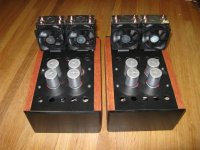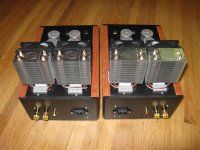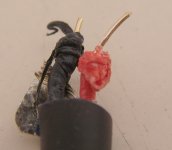Pictures, or it didn't happen!
Here it is. I knew it was going to be very special amp, so I decided to make it look different.
I went with heat pipes, as the least expensive finned aluminum heat sinks would cost me around $120. Those were $14 each delivered. Saved some $$$, but took way more time to build. Because of limited chassis size, caps were mounted on the outside. Reminds me of a tube amp.
Voltage regulator circuit had to be added, so fans can get 5V-12V range from 48V. I may swap it for temperature controller circuit in the future.
Each channel has 300VA Antec 2x18, 4 x 47'000uF caps, bride rectifiers are on internal heat sinks, and they do get warm. I have drilled some holes in top and bottom surfaces to allow for natural air convection. I may add another small quiet fan on the back surface to lower the internal temperature.
The heat pipe approach works great. Each can dissipate 90W with fan at full speed, so it can dissipate less with fan at lower speed. eBay has plenty of heat pipe sinks from older hot P4s that would work great for class A output devices, with some modifications of course...
Still need to add fuses
Once again, thank you for sharing the design Mr. Pass.
Attachments
Last edited:
no coax - just two twisted tiniest wires ......
its better to ripoff the two cables? Now the red is for the signal and the black together with the shield are for ground!
Its a balanced version.
Ps. michal nice idea!
I use only one fan for my Pc so as to enjoy late night music...
Attachments
Here it is. I knew it was going to be very special amp, ...
I would have voted to have the fans at the back to blow the heat into the room...
That's how there were originally mounted, but then the heated air was getting onto the caps, and caps were getting warmed up.I would have voted to have the fans at the back to blow the heat into the room...
Michal, Congratulations on a successful project!
Could you describe a bit more about how the heat pipes were attached, mounted etc. I am not familiar with these and a description/photos would be much appreciated. I have used fans in the past and they can solve a number of problems. Your build is so compact and attractive.
Thanks
Could you describe a bit more about how the heat pipes were attached, mounted etc. I am not familiar with these and a description/photos would be much appreciated. I have used fans in the past and they can solve a number of problems. Your build is so compact and attractive.
Thanks
I love the different variations. Nice job to both of you!
Have considered the heatpipes many times but am always at the electronics store looking at them and wondering 'well, how much heat do they dissipate?" The manufacturers dont often post dissipation on the packaging of the heatpipe heatsinks.
I use 30awg silver wire and then put teflon tube on it. One ground one signal. Switchcraft RCAs. Nice sound.
Uriah
Have considered the heatpipes many times but am always at the electronics store looking at them and wondering 'well, how much heat do they dissipate?" The manufacturers dont often post dissipation on the packaging of the heatpipe heatsinks.
I use 30awg silver wire and then put teflon tube on it. One ground one signal. Switchcraft RCAs. Nice sound.
Uriah
Thanks for the positive feedback 
Heat pipes are now very popular in computer processor cooling, and CPUs usually dissipate > 60W when fully loaded. CPU coolers also have to work inside the computer case, thus with higher ambient temperature. So such cooler will have excellent performance handling lower dissipation, at lower ambient temperature with lower fan speed.
After I saw one fellow diy'er using them as well, and chatting with bear and gmilitano I decided to go for it.
I got mine at ncix.com, price matched trough shopbot.ca. They are Coolermaster Hyper 101I Direct Contact 2 Heatpipe CPU Heatsink for socket LGA1156 and LGA775 with 80MM Bearing Fan.
One can use even quieter fan, look for heat sink and fan recommendations at silentpcreview.com, but then costs go up.
Mounting was time consuming. I had to drill bigger holes, get some aluminum bar to attach the transistor to the heat sink, as well as attach the heat sink to the chassis, and then PCB to the transistors. I'm in a process of making up a page explaining the construction.
B1 and iBiBs with FE127e are next
Heat pipes are now very popular in computer processor cooling, and CPUs usually dissipate > 60W when fully loaded. CPU coolers also have to work inside the computer case, thus with higher ambient temperature. So such cooler will have excellent performance handling lower dissipation, at lower ambient temperature with lower fan speed.
After I saw one fellow diy'er using them as well, and chatting with bear and gmilitano I decided to go for it.
I got mine at ncix.com, price matched trough shopbot.ca. They are Coolermaster Hyper 101I Direct Contact 2 Heatpipe CPU Heatsink for socket LGA1156 and LGA775 with 80MM Bearing Fan.
One can use even quieter fan, look for heat sink and fan recommendations at silentpcreview.com, but then costs go up.
Mounting was time consuming. I had to drill bigger holes, get some aluminum bar to attach the transistor to the heat sink, as well as attach the heat sink to the chassis, and then PCB to the transistors. I'm in a process of making up a page explaining the construction.
B1 and iBiBs with FE127e are next
those spks are good for nothing - plain screamers ;
send them to me , for proper disposal ; you'll pay shipment , I have no intention to make double favor to you
- try tiny solid core for input signal wires - 0,1mm dia , twisted .
Wow ZM,
38 gauge wire!
I've tried as low as 32 gauge but found the sweet spot (in the equipment I was using at the time) to be between 24 and 28. For speaker wire I'm currently using 20g. But hey, with 38g wire even gold would be affordable
F5 with top end of Infinity RS1b's??
I am just about to set up my first formal listening room and in this room I have been waiting to set up my newly acquired pair of Infinity RS-1b speakers.
Thus far my F5 has been used to drive a pair of Infinity Composition Prelude speakers which are 94db efficient (and have built in sub amps). And to say the F5 amplifier sounds great with these speakers would be an understatement.
My question is, will the F5 be up to the task of driving the ribbon tweeter and midrange panel array found in the RS1b's? The RS1'b's have to be biamped, and the bass arrays will be driven by the "heftier" Pass designed Adcom 555II, or a pair of Adcom 565's, or a Bryston 4bst
Anybody with thoughts?
Thanks,
Justin Wade
I am just about to set up my first formal listening room and in this room I have been waiting to set up my newly acquired pair of Infinity RS-1b speakers.
Thus far my F5 has been used to drive a pair of Infinity Composition Prelude speakers which are 94db efficient (and have built in sub amps). And to say the F5 amplifier sounds great with these speakers would be an understatement.
My question is, will the F5 be up to the task of driving the ribbon tweeter and midrange panel array found in the RS1b's? The RS1'b's have to be biamped, and the bass arrays will be driven by the "heftier" Pass designed Adcom 555II, or a pair of Adcom 565's, or a Bryston 4bst
Anybody with thoughts?
Thanks,
Justin Wade
The manufacturers dont often post dissipation on the packaging of the heatpipe heatsinks.
These guys do - FrostyTech - Best Heat Sinks & PC Cooling Reviews
And they test those things at a few different dissipation levels, which is also useful, as are the noise results
These guys do - FrostyTech - Best Heat Sinks & PC Cooling Reviews
And they test those things at a few different dissipation levels, which is also useful, as are the noise results
Thanks for the link!
I vote against any fans, but i have a very quiet environment... transformer buzz, if it happens can be annoying.
If I was going to attempt a fan, I'd recommend a pressurized chassis/chamber using a centrifugal blower, oversized and running slow to keep the HF noise quiet... the pressurized chamber/chassis is to provide "inside" airflow that then passes through the fins to the outside... this will minimize the noise if done well, but not the size...depending on the choice and method of mounting the blower...
I am curious, how hot do the fins on the heatpipe heatsinks get without the blower, and with - and are you using a temperature proportional control of the DC voltage to the fans??
_-_-bear
If I was going to attempt a fan, I'd recommend a pressurized chassis/chamber using a centrifugal blower, oversized and running slow to keep the HF noise quiet... the pressurized chamber/chassis is to provide "inside" airflow that then passes through the fins to the outside... this will minimize the noise if done well, but not the size...depending on the choice and method of mounting the blower...
I am curious, how hot do the fins on the heatpipe heatsinks get without the blower, and with - and are you using a temperature proportional control of the DC voltage to the fans??
_-_-bear
I vote against any fans, but i have a very quiet environment...
Fans fail...
But I use them in an LM4780 bridge amplifier -- fans are also cheaper than more cubic inches on a heat sink.
Fans fail...
But I use them in an LM4780 bridge amplifier -- fans are also cheaper than more cubic inches on a heat sink.
Thats why you should run them off a temperature sensor that only turns them on when the amp gets warm.
Or use a variable speed fan that is slow/off and quiet on low volumes.
Those sinks arent going to cool enough to keep the F5 alive if they fail. But yeah, its probably worth the savings in size and the way we guys go through amps the fans probably wont end up failing on that F5. When is the last time your computer fan failed? Never had it happen to me.
Uriah
Uriah
Everything fails, it's just a matter of time. Computer fans are rated for more than 20'000 hours. Harsh conditions will make fan fail much sooner: dust/grease, high temperature, high RPMs, improper mounting.
As for noise, under volted fans can be inaudible in this application.
A simple circuit can be added to monitor if fan is spinning, and if not, an alarm can be activated, or even power turned off. It complicates the design, but that's the trade of for not using large finned heat sinks.
As for noise, under volted fans can be inaudible in this application.
A simple circuit can be added to monitor if fan is spinning, and if not, an alarm can be activated, or even power turned off. It complicates the design, but that's the trade of for not using large finned heat sinks.
Everything fails, it's just a matter of time. Computer fans are rated for more than 20'000 hours. Harsh conditions will make fan fail much sooner: dust/grease, high temperature, high RPMs, improper mounting.
As for noise, under volted fans can be inaudible in this application.
A simple circuit can be added to monitor if fan is spinning, and if not, an alarm can be activated, or even power turned off. It complicates the design, but that's the trade of for not using large finned heat sinks.
Anyone with a 'fridge bought in the last 3 or 4 years can attest to this. Not to be xenophobic (i.e. not to praise Caesar, but to bury him...) the crop of fans for consumer appliances made in low-cost environs are failing at a pretty astounding rate. Kitchen-Aid has an entire protocol for dealing with irate costumers, so I am sure that all the companies who fall under their umbrella (Maytag etc) have the same. Failure of the fan leads to failure of the switch-mode power supply due to overheating, and controller so you're left with a $600 mess unless you kick and scream. Any energy savings are lost by the cost of repairs.
(snip)When is the last time your computer fan failed? Never had it happen to me.
Uriah
I maintain about 20 high-end PCs. Each has 5-9 fans. Of 150 "quality" fans you can expect 5-10 per year to fail after the four years of 24/7 operation.
Last edited:
- Home
- Amplifiers
- Pass Labs
- F5 power amplifier



